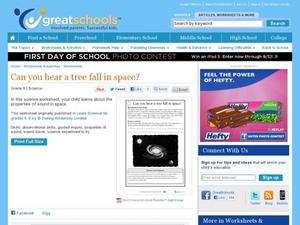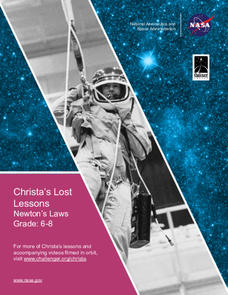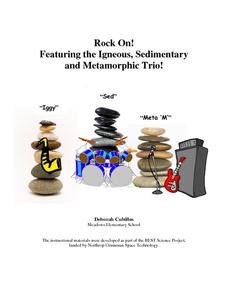Curated OER
Engineering Lessons Adapted for Special Education
Modifying engineering lessons from NASA makes them accessible to a wider variety of learners.
Baylor College
Examining the Heart
Break hearts with this lesson plan: chicken or sheep hearts, that is! Your class examines the external and internal structure of the heart with a dissection activity. A handy anatomy resource provides the necessary materials for...
Growing Classroom
Space Travelers
Groups of three scientists from the rocky planet Zog investigate the composition of soil so that they can take the information back to their home, create soil there, and begin to grow food.
Curated OER
Kids in Outer Space
Students explore outer space through various activities. In this outer space lesson plan, students read the book Outer Space and The Mice on the Moon. Students work in groups to build their own space ships.
Curated OER
Exploring Space Fact
Learners visit web sites to gather information about space and space exploration.
Curated OER
Applied Science - Built Environment (6) Lab
Sixth graders look at toys in space. In this gravity lesson, 6th graders make predictions about what different toys will do with zero gravity. They watch a space video and see what happens to these toys in space.
University of Colorado
Happy Landings: A Splash or a Splat?
Huygens spacecraft landed on Saturn's moon Titan in 2005, making it the farthest landing from Earth ever made by a spacecraft. In this hands-on activity, the 12th installment of 22, groups explore how density affects speed. To do this,...
Curated OER
Technology for Studying Comets
Students design an Aerogel model to capture clay particles. In this space science lesson plan, students discover what happens to comets as they hit a surface. They explain how the Aerogel technology would help scientists study comets...
Curated OER
Mission Complete, Houston
It was a bittersweet event when the space shuttle Atlantis touched down for the last time on July 21, 2011. Space science learners read an article about this event in The New York Times and then write answers to who, what, where, when,...
Curated OER
The Nine Planets
A solid lesson on teaching the nine planets in our solar system is here for you. In it, young scientists learn the correct order of the planets, and they choose one of the planets to do a research report on. They must come up with five...
Curated OER
Houston, We Have a Problem! An Introductory Lesson for the unit Stars, Galaxies and the Universe
The lesson plan would make a stimulating introduction to a space unit. It is highly imaginative and suggests that the teacher darken the room to set the mood and dress as an astronaut. Teams are asked to help solve an imaginary problem...
Mr. E. Science
The Earth in Space
Do you think Earth makes fun of other planets for having no life? The presentation covers the rotation and revolution of both the earth and our moon. It provides explanations for seasons, tides, and eclipses. Lesson is the 20th in a...
Curated OER
Life In Space: The International Space Station
Students learn about the International Space Station. In this space lesson, students learn about the structure, operations, and experiments that go on in the International Space Station.
Curated OER
Making Regolith
You may not be able to take a field trip to the moon, but that doesn't mean your class can't study moon rocks. Using graham crackers as the moon's bedrock and powdered donuts as micrometeorites, young scientists simulate the creation of...
Curated OER
NASA Plans Moon Base
Students react to statements about the moon, then read a news article about NASA's plans to build a permanent base on the moon. For this space science and current events lesson, the teacher introduces the article with a discussion and a...
Curated OER
Top 10 Facts About Space
Students create their own Top 10 Facts about any topic related to space. In this space lesson, students work in groups to produce a Top Ten List of facts about space and share with their classmates. Groups choose a fact to research and...
Curated OER
Can You Hear a Tree Fall in Space?
How does sound travel in space? Fifth graders investigate this question with a science activity, in which they research the properties of sound. Schedule a lab visit for individual Internet research, or include the activity after you...
PHET
Learning about Space Weather
Is the sun the only celestial body with magnetic fields? A guided discussion on the weather in space is designed with a mix of questions, discussions, explanations, and applications. Additionally, the resouce includes an article for...
NASA
Tools of the Trade
Did you know every state in the U.S. has at least one observatory? During the lesson, scholars research the cost of building and maintaining an observatory. They must present their information in a proposal to build a new observatory,...
Curated OER
Regolith Formation
Students explain the difference between regolith formation on Earth and the Moon. For this space science lesson, students model the different factors affecting regolith formation on Earth. They identify the different types of weathering.
Space Awareness
Ocean Acidification
Learn the science behind ocean acidification and its effects on ocean wildlife. Young scientists conduct a laboratory investigation that monitors the acidity level of water. While burning a candle, learners capture the carbon dioxide in...
NASA
Christa's Lost Lesson: Newton’s Laws
How do the laws of motion work in space? Learners explore Newton's laws of motion in different experiments as part of the Christa's Lost Lessons series. They rotate around the room in three stations to experience each law in action using...
Curated OER
Rock On! Featuring the Igneous, Sedimentary and Metamorphic Trio!
Get your classroom rocking with this four-lesson earth science unit. Through a series of shared reading activities and hands-on investigations, young geologists learn about the three types of rocks and the unique properties of each.
NASA
Cosmic Microwave Background
Begin your next class with a BANG! Pupils discuss the formation of our universe and its expansion before proceeding with an activity designed to demonstrate what most likely occurred billions of years ago. They conclude with a discussion...

























